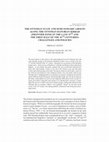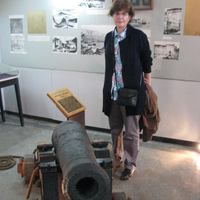Books by Nikolay Antov
Papers by Nikolay Antov
Radovi-Zavod za hrvatsku povijest, vol. 51, No. 1, 2019

Poseban broj Radova Zavoda za hrvatsku povijest. Između Europe i Bliskog istoka: migracije i njihove posljedice na području Jugoistočne Europe i Anaodlije u transimperijalnom i interkulturalnom kontekstu, 2019
Vol. 51, No. 1 (2019)
Table of Contents / Sadržaj:
1) Vjeran Kursar, Uvod gostujućeg urednika. ... more Vol. 51, No. 1 (2019)
Table of Contents / Sadržaj:
1) Vjeran Kursar, Uvod gostujućeg urednika. Između Europe i Bliskog istoka: migracije i njihove posljedice na području Jugoistočne Europe i Anadolije u transimperijalnom i interkulturalnom kontekstu
Vjeran Kursar, Guest Editor’s Introduction: Between Europe and Middle East: Migrations and Their Consequences in of Southeast Europe and Anatolia in Transimperial and Intercultural Context
2) Jasmina Osterman, Amoritski identitet: simbol MAR u protoklinastim izvorima (Amorite Identity: Symbol MAR in Protocuneiform Sources)
3) Nikolay Antov, Demographic and Ethno-Religious Change in 15th- and 16th-Century Ottoman Dobrudja (NE Balkans) and the Related Impact of Migrations
4) Kayhan Orbay, “They Left Behind Institutions in Financial Jeopardy”: Central Anatolian Waqfs in the Wake of Great Flight
5) Eujeong Yi, Interreligious Relations in 17th-Century Istanbul in the Light of Immigration and Demographic Change
6) Silvana Rachieru, Between the King and the Sultan: the Romanian Colony in Constantinople at the End of the 19th Century
7) Nada Zečević, Restoration, Reconstruction and the Union: Memories of Home in the Stratiot Poetry of Antonio Molino
8) Robert Skenderović, Ekološko-geografska determiniranost koloniziranja Slavonije u 18. stoljeću
9) Stefan Rohdewald & Florian Riedler, Migration and Mobility in a Transottoman Context
This issue is dedicated to the phenomenon of migrations in history. The idea was to approach migrations diachronically, from the ancient migrations to the modern era and the end of the 19th century. The starting point is the assumption that major patterns, as well as social function of migration, did not change substantially over time, despite significant alterations of external factors, technological progress, quantitative volume, as well as changes and acceleration of the rhythm. Spatially, the focus is on migrations between the Middle East, the Balkans, and East- and Central Europe, extending over an area that represents an “intercontinental bridge” between not only geographic units, but specific cultural, historic, political, religious, societal, ethnic, and even civilizational entities. The aim of the present issue is not only to determine the directions of migrant movement (origin and final destinations), but to analyze the nature of migration, its causes and effects it had on migrants, as well as their original and host communities (and/or states).
Ovaj broj Radova Zavoda za hrvatsku povijest posvećen je fenomenu migracija u povijesti. Zamisao je bila migracijama pristupiti u dijakronoj perspektivi, od prvih povijesnih, starovjekovnih migracija do modernog doba i konca 19. stoljeća, polazeći od pretpostavke da se ključni obrasci, kao i socijalna uloga migracija, nisu bitno mijenjali unatoč znatnim promjenama izvanjskih danosti, tehnološkom napretku, kvantitativnom opsegu te promjenama i ubrzanju ritma migracija. U prostornom smislu, fokus ovoga broja je na migracijama na Bliskom istoku, Balkanu te Istočnoj i Srednjoj Europi, dakle, na prostoru koji do danas predstavlja “interkontinentalni most” između ne samo geografskih cjelina, nego i kulturno, povijesno, politički, vjerski, društveno, etnički, pa čak i civilizacijski zasebnih entiteta. Cilj broja, u navedenom kontekstu, nije samo utvrditi pravce kretanja migranata (ishodište i odredište), nego i analizirati prirodu samih migracija, njihove uzroke i posljedice, kako za migrante, tako i za društva (i države) koja napuštaju i ona u koje se doseljavaju.
Beyond Mosque, Church, and State: Alternative Narratives of the Nation in the Balkans, edited by Theodora Dragostinova and Yana Hashamova (Budapest & New York: CEU Press, 2016), 2016
JSTOR is a not-for-profit service that helps scholars, researchers, and students discover, use, a... more JSTOR is a not-for-profit service that helps scholars, researchers, and students discover, use, and build upon a wide range of content in a trusted digital archive. We use information technology and tools to increase productivity and facilitate new forms of scholarship. For more information about JSTOR, please contact support@jstor.org.
"Crusading in the Fifteenth Century and Its Relation to the Development of Ottoman Dynastic Legit... more "Crusading in the Fifteenth Century and Its Relation to the Development of Ottoman Dynastic Legitimacy, Self-Image, and the Ottoman Consolidation of Authority," in "The Crusade in the Fifteenth Century: Converging and Competing Cultures," ed. Norman Housley (London: Routledge, 2016), 15-33.

The main subject of this article is the relationship between the Ottoman state and semi-nomadic g... more The main subject of this article is the relationship between the Ottoman state and semi-nomadic groups in the Ottoman Danubian frontier zone (serhad) in the late 15 th and the first half of the 16 th century. Taking the two extremities of the Danubian frontier zone – the provinces of Smederevo in Serbia and Silistre in the northeastern Balkans – as case studies, the article compares the ways in which the Ottoman state dealt with semi-nomadic Vlachs at one end of the frontier zone and Turcoman yürüks (and related groups) at the other. Placing the subject in the broader context of the historical development of the Danubian frontier zone, the author analyzes the Ottoman state's changing policies toward these two groups. Taking into account the largely different historical legacies and demographic make-ups, the article analyzes the many commonalities (as well as some important differences) in the way the Ot-toman government integrated such groups in its administrative structure. It highlights the process in which such semi-nomadic groups, traditionally utilized by the Ottoman state as auxiliary soldiers, were gradually " tamed " by the state in the course of the 16 th century, becoming gradually sedentarized and losing their privileged status.
Comparative Studies of South Asia Africa and the Middle East, 2008
Workshops & Conferences by Nikolay Antov
by Emin Lelić, B. Harun Küçük, Şaban Ağalar, Duygu Yildirim, Ayşe Baltacıoğlu-Brammer, Cornell Fleischer, Kameliya Atanasova, Ahmet Yusuf Yuksek, Burcak Ozludil, Pinar Odabasi Tasci, Ella Fratantuono, and Nikolay Antov










Uploads
Books by Nikolay Antov
Papers by Nikolay Antov
Table of Contents / Sadržaj:
1) Vjeran Kursar, Uvod gostujućeg urednika. Između Europe i Bliskog istoka: migracije i njihove posljedice na području Jugoistočne Europe i Anadolije u transimperijalnom i interkulturalnom kontekstu
Vjeran Kursar, Guest Editor’s Introduction: Between Europe and Middle East: Migrations and Their Consequences in of Southeast Europe and Anatolia in Transimperial and Intercultural Context
2) Jasmina Osterman, Amoritski identitet: simbol MAR u protoklinastim izvorima (Amorite Identity: Symbol MAR in Protocuneiform Sources)
3) Nikolay Antov, Demographic and Ethno-Religious Change in 15th- and 16th-Century Ottoman Dobrudja (NE Balkans) and the Related Impact of Migrations
4) Kayhan Orbay, “They Left Behind Institutions in Financial Jeopardy”: Central Anatolian Waqfs in the Wake of Great Flight
5) Eujeong Yi, Interreligious Relations in 17th-Century Istanbul in the Light of Immigration and Demographic Change
6) Silvana Rachieru, Between the King and the Sultan: the Romanian Colony in Constantinople at the End of the 19th Century
7) Nada Zečević, Restoration, Reconstruction and the Union: Memories of Home in the Stratiot Poetry of Antonio Molino
8) Robert Skenderović, Ekološko-geografska determiniranost koloniziranja Slavonije u 18. stoljeću
9) Stefan Rohdewald & Florian Riedler, Migration and Mobility in a Transottoman Context
This issue is dedicated to the phenomenon of migrations in history. The idea was to approach migrations diachronically, from the ancient migrations to the modern era and the end of the 19th century. The starting point is the assumption that major patterns, as well as social function of migration, did not change substantially over time, despite significant alterations of external factors, technological progress, quantitative volume, as well as changes and acceleration of the rhythm. Spatially, the focus is on migrations between the Middle East, the Balkans, and East- and Central Europe, extending over an area that represents an “intercontinental bridge” between not only geographic units, but specific cultural, historic, political, religious, societal, ethnic, and even civilizational entities. The aim of the present issue is not only to determine the directions of migrant movement (origin and final destinations), but to analyze the nature of migration, its causes and effects it had on migrants, as well as their original and host communities (and/or states).
Ovaj broj Radova Zavoda za hrvatsku povijest posvećen je fenomenu migracija u povijesti. Zamisao je bila migracijama pristupiti u dijakronoj perspektivi, od prvih povijesnih, starovjekovnih migracija do modernog doba i konca 19. stoljeća, polazeći od pretpostavke da se ključni obrasci, kao i socijalna uloga migracija, nisu bitno mijenjali unatoč znatnim promjenama izvanjskih danosti, tehnološkom napretku, kvantitativnom opsegu te promjenama i ubrzanju ritma migracija. U prostornom smislu, fokus ovoga broja je na migracijama na Bliskom istoku, Balkanu te Istočnoj i Srednjoj Europi, dakle, na prostoru koji do danas predstavlja “interkontinentalni most” između ne samo geografskih cjelina, nego i kulturno, povijesno, politički, vjerski, društveno, etnički, pa čak i civilizacijski zasebnih entiteta. Cilj broja, u navedenom kontekstu, nije samo utvrditi pravce kretanja migranata (ishodište i odredište), nego i analizirati prirodu samih migracija, njihove uzroke i posljedice, kako za migrante, tako i za društva (i države) koja napuštaju i ona u koje se doseljavaju.
Workshops & Conferences by Nikolay Antov
Table of Contents / Sadržaj:
1) Vjeran Kursar, Uvod gostujućeg urednika. Između Europe i Bliskog istoka: migracije i njihove posljedice na području Jugoistočne Europe i Anadolije u transimperijalnom i interkulturalnom kontekstu
Vjeran Kursar, Guest Editor’s Introduction: Between Europe and Middle East: Migrations and Their Consequences in of Southeast Europe and Anatolia in Transimperial and Intercultural Context
2) Jasmina Osterman, Amoritski identitet: simbol MAR u protoklinastim izvorima (Amorite Identity: Symbol MAR in Protocuneiform Sources)
3) Nikolay Antov, Demographic and Ethno-Religious Change in 15th- and 16th-Century Ottoman Dobrudja (NE Balkans) and the Related Impact of Migrations
4) Kayhan Orbay, “They Left Behind Institutions in Financial Jeopardy”: Central Anatolian Waqfs in the Wake of Great Flight
5) Eujeong Yi, Interreligious Relations in 17th-Century Istanbul in the Light of Immigration and Demographic Change
6) Silvana Rachieru, Between the King and the Sultan: the Romanian Colony in Constantinople at the End of the 19th Century
7) Nada Zečević, Restoration, Reconstruction and the Union: Memories of Home in the Stratiot Poetry of Antonio Molino
8) Robert Skenderović, Ekološko-geografska determiniranost koloniziranja Slavonije u 18. stoljeću
9) Stefan Rohdewald & Florian Riedler, Migration and Mobility in a Transottoman Context
This issue is dedicated to the phenomenon of migrations in history. The idea was to approach migrations diachronically, from the ancient migrations to the modern era and the end of the 19th century. The starting point is the assumption that major patterns, as well as social function of migration, did not change substantially over time, despite significant alterations of external factors, technological progress, quantitative volume, as well as changes and acceleration of the rhythm. Spatially, the focus is on migrations between the Middle East, the Balkans, and East- and Central Europe, extending over an area that represents an “intercontinental bridge” between not only geographic units, but specific cultural, historic, political, religious, societal, ethnic, and even civilizational entities. The aim of the present issue is not only to determine the directions of migrant movement (origin and final destinations), but to analyze the nature of migration, its causes and effects it had on migrants, as well as their original and host communities (and/or states).
Ovaj broj Radova Zavoda za hrvatsku povijest posvećen je fenomenu migracija u povijesti. Zamisao je bila migracijama pristupiti u dijakronoj perspektivi, od prvih povijesnih, starovjekovnih migracija do modernog doba i konca 19. stoljeća, polazeći od pretpostavke da se ključni obrasci, kao i socijalna uloga migracija, nisu bitno mijenjali unatoč znatnim promjenama izvanjskih danosti, tehnološkom napretku, kvantitativnom opsegu te promjenama i ubrzanju ritma migracija. U prostornom smislu, fokus ovoga broja je na migracijama na Bliskom istoku, Balkanu te Istočnoj i Srednjoj Europi, dakle, na prostoru koji do danas predstavlja “interkontinentalni most” između ne samo geografskih cjelina, nego i kulturno, povijesno, politički, vjerski, društveno, etnički, pa čak i civilizacijski zasebnih entiteta. Cilj broja, u navedenom kontekstu, nije samo utvrditi pravce kretanja migranata (ishodište i odredište), nego i analizirati prirodu samih migracija, njihove uzroke i posljedice, kako za migrante, tako i za društva (i države) koja napuštaju i ona u koje se doseljavaju.